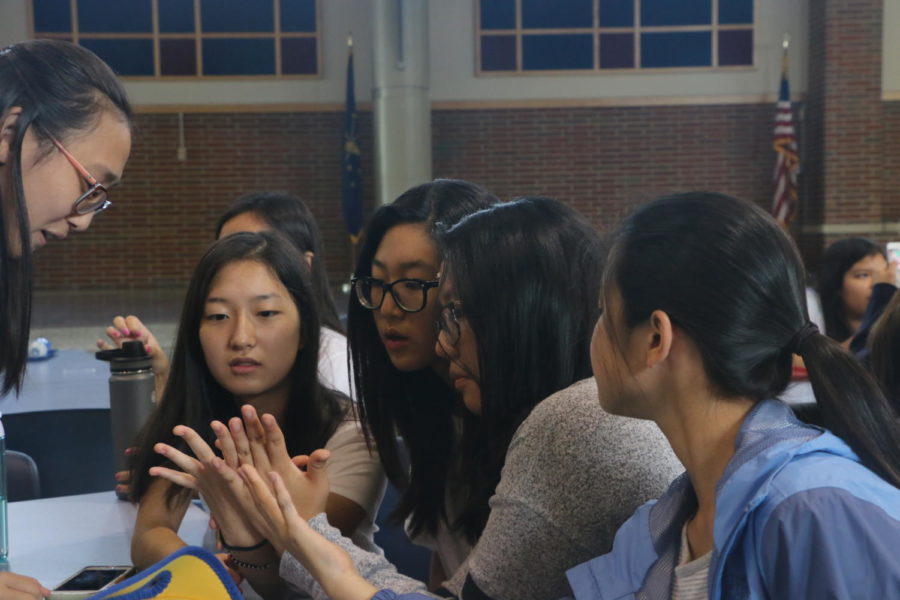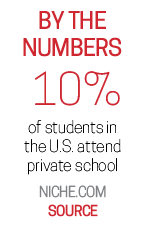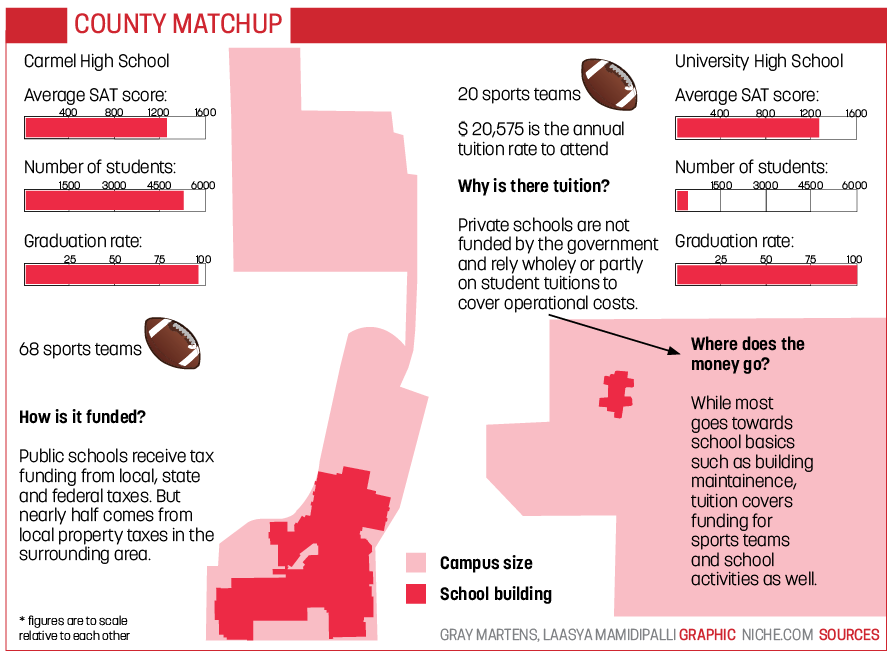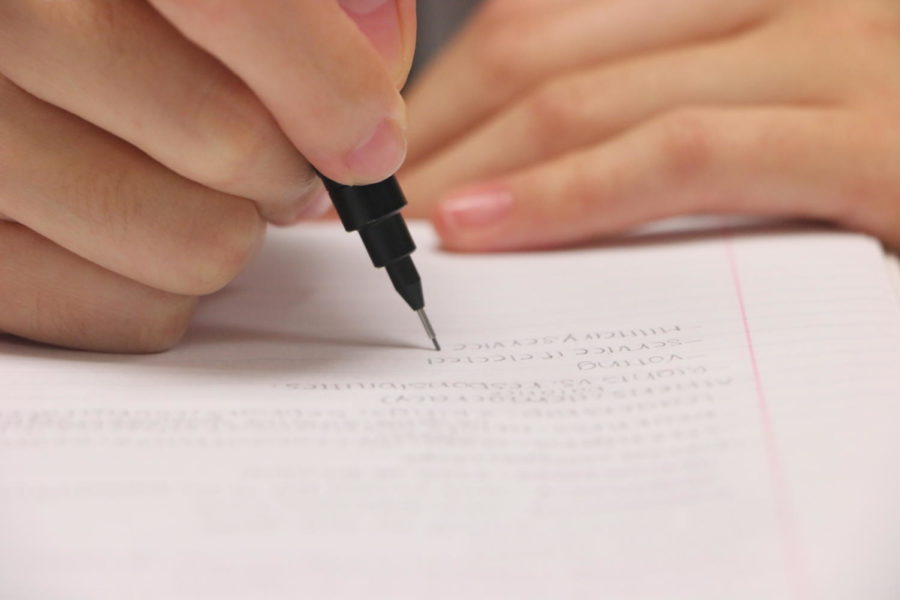A mass of students travel from the A rooms to B rooms. Students shuffle through the never-ending line of traffic spilling over between the two main hallways. For freshman Abby Ko, this experience was something new. Ko went from traveling through one hallway with all her classes to the largest public school in Indiana. Ko attended Sycamore School (a private school for gifted children grades K to 8) for most of her life.
Ko said there is a large contrast between attending Sycamore and CHS, from walking through the hallways to the many classes and clubs offered.
“I would say the biggest difference is that, in private schools, teachers are more approachable and I guess they’ll know you better so they’ll plan out the class schedule and lesson plans and stuff based on the kids in their class and not necessarily trying to get everything done in a year,” Ko said.
At Sycamore, with just about 40 students per grade, the classrooms are filled with both students and teachers who are all familiar with one another. Housing over 5,000 students, CHS is just the opposite—with students of all interests, many of whom are strangers to one another, much like many of the other public school across the country. Both settings bring different experiences to the students.

Freshman Abby Ko (far left) socializes with her friends during lunch. She said a drawback to private schools is the smaller student body, which restricts activities available to public school students.
Seeing new faces in the hallways each day can be difficult for students to see the same friends each day, but according to Assistant Principal Valerie Piehl, who has had experience working in different public schools, public schools offer connections to people that can not be made at private schools.
“Public schools provide great opportunities for all students living in the district; they offer great diversity as you have people coming in with different backgrounds, different religions, with different stories,” Piehl, who worked at Fishers High School before coming here, said.

Shants Hart, associate head of school at Park Tudor, a private school in Indianapolis, has also experienced teaching at public schools and offered her insight, explaining that because of their small size, private schools offer greater opportunities to participate in extracurricular activities and a closer student-teacher interaction. Additionally, she said teachers have more flexibility in planning their class schedules.
“At Park Tudor, we were allowed to have far more say in our teaching,” Harts said. “We were allowed to be more creative. We were allowed to be our own designers for our curriculum. We were able to take a constructivist approach to teaching and learning. We were allowed to let kids discover. Therefore, teachers have more autonomy.”
As for participation in activities, Ko said she recalls some drawbacks Sycamore faced when it came to sports.
“We had pretty much all the basic [sports teams] but what’s sad is that sometimes there wouldn’t even be enough people signed up for a team that they would cancel it for that season,” Ko said.
And while many clubs here at CHS are often centered around certain student interests, Ko said this was not the case at Sycamore.
“It was just more of the academic teams [like] Science Bowl and MathCounts,” Ko said. “It wasn’t really like ‘Ski Club’ or something; it was just like whatever you had that was available.”
Along with clubs, the curriculum is a major contrast between the two types of schools. According to Piehl, public schools are required to follow a set of state-approved classes whereas private schools can create their own curriculum based on their standards.
 Laasya Mamidipalli, Gray Martens
Laasya Mamidipalli, Gray Martens
In addition to those differences, private school courses can often be more rigorous and can also be focused more deeply on specific topics such as religion or math. Because students must choose to go to that specific school, they are able to cater their focus on certain topics throughout the school year.
For example, Ko said, “In our history class [at Sycamore School], my teacher kind of modeled his class after an AP history class and so, you know, that obviously helped a lot. Sycamore’s a very math- and science-based school.”
There are various reasons why families prefer one over the other. One of the major reasons is the price tag. According to the National Center of Education Statistics (NCES), the average amount families paid to attend a private secondary school in 2011 was $13,030, while the cost of public schools depends on the district. This hefty price tag is not something everyone can afford, which can be a major reason why families are drawn to public schools.
Religion is another consideration. Many private schools are religiously based, with 36 percent of private schools being Catholic according to NCES.
“Going to a private school sometime in your life is definitely a privilege, in my opinion,” Ko said, “It’s very beneficial but at some point you have to go to a public school just for that experience.”




























![Keep the New Gloves: Fighter Safety Is Non-Negotiable [opinion]](https://hilite.org/wp-content/uploads/2024/12/ufcglovescolumncover-1200x471.png)
















































![Review: “We Live in Time” leaves you wanting more [MUSE]](https://hilite.org/wp-content/uploads/2024/12/IMG_6358.jpg)
![Review: The premise of "Culinary Class Wars" is refreshingly unique and deserving of more attention [MUSE]](https://hilite.org/wp-content/uploads/2024/12/MUSE-class-wars-cover-2.png)
![Introducing: "The Muses Who Stole Christmas," a collection of reviews for you to follow through winter [MUSE]](https://hilite.org/wp-content/uploads/2024/12/winter-muse-4.gif)
![Review: "Meet Me Next Christmas" is a cheesy and predictable watch, but it was worth every minute [MUSE]](https://hilite.org/wp-content/uploads/2024/11/AAAAQVfRG2gwEuLhXTGm3856HuX2MTNs31Ok7fGgIVCoZbyeugVs1F4DZs-DgP0XadTDrnXHlbQo4DerjRXand9H1JKPM06cENmLl2RsINud2DMqIHzpXFS2n4zOkL3dr5m5i0nIVb3Cu3ataT_W2zGeDAJNd_E-1200x884.jpg)
![Review: "Gilmore Girls", the perfect fall show [MUSE]](https://hilite.org/wp-content/uploads/2024/11/gilmore-girls.png)
![Review in Print: Maripaz Villar brings a delightfully unique style to the world of WEBTOON [MUSE]](https://hilite.org/wp-content/uploads/2023/12/maripazcover-1200x960.jpg)
![Review: “The Sword of Kaigen” is a masterpiece [MUSE]](https://hilite.org/wp-content/uploads/2023/11/Screenshot-2023-11-26-201051.png)
![Review: Gateron Oil Kings, great linear switches, okay price [MUSE]](https://hilite.org/wp-content/uploads/2023/11/Screenshot-2023-11-26-200553.png)
![Review: “A Haunting in Venice” is a significant improvement from other Agatha Christie adaptations [MUSE]](https://hilite.org/wp-content/uploads/2023/11/e7ee2938a6d422669771bce6d8088521.jpg)
![Review: A Thanksgiving story from elementary school, still just as interesting [MUSE]](https://hilite.org/wp-content/uploads/2023/11/Screenshot-2023-11-26-195514-987x1200.png)
![Review: "When I Fly Towards You", cute, uplifting youth drama [MUSE]](https://hilite.org/wp-content/uploads/2023/09/When-I-Fly-Towards-You-Chinese-drama.png)
![Postcards from Muse: Hawaii Travel Diary [MUSE]](https://hilite.org/wp-content/uploads/2023/09/My-project-1-1200x1200.jpg)
![Review: "Ladybug & Cat Noir: The Movie," departure from original show [MUSE]](https://hilite.org/wp-content/uploads/2023/09/Ladybug__Cat_Noir_-_The_Movie_poster.jpg)
![Review in Print: "Hidden Love" is the cute, uplifting drama everyone needs [MUSE]](https://hilite.org/wp-content/uploads/2023/09/hiddenlovecover-e1693597208225-1030x1200.png)
![Review in Print: "Heartstopper" is the heartwarming queer romance we all need [MUSE]](https://hilite.org/wp-content/uploads/2023/08/museheartstoppercover-1200x654.png)




